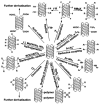Synthesis of Carbon Nanomaterials from Biomass Utilizing Ionic Liquids for Potential Application in Solar Energy Conversion and Storage
- PMID: 32906574
- PMCID: PMC7558495
- DOI: 10.3390/ma13183945
Synthesis of Carbon Nanomaterials from Biomass Utilizing Ionic Liquids for Potential Application in Solar Energy Conversion and Storage
Abstract
Considering its availability, renewable character and abundance in nature, this review assesses the opportunity of the application of biomass as a precursor for the production of carbon-based nanostructured materials (CNMs). CNMs are exceptionally shaped nanomaterials that possess distinctive properties, with far-reaching applicability in a number of areas, including the fabrication of sustainable and efficient energy harnessing, conversion and storage devices. This review describes CNM synthesis, properties and modification, focusing on reports using biomass as starting material. Since biomass comprises 60-90% cellulose, the current review takes into account the properties of cellulose. Noting that highly crystalline cellulose poses a difficulty in dissolution, ionic liquids (ILs) are proposed as the solvent system to dissolve the cellulose-containing biomass in generating precursors for the synthesis of CNMs. Preliminary results with cellulose and sugarcane bagasse indicate that ILs can not only be used to make the biomass available in a liquefied form as required for the floating catalyst CVD technique but also to control the heteroatom content and composition in situ for the heteroatom doping of the materials.
Keywords: biomass; carbon-based nanostructured material; cellulose; energy; ionic liquids.
Conflict of interest statement
The authors declare no conflict of interest.
Figures







Similar articles
-
Updating biomass into functional carbon material in ionothermal manner.ACS Appl Mater Interfaces. 2014 Aug 13;6(15):12515-22. doi: 10.1021/am5023682. Epub 2014 Jul 16. ACS Appl Mater Interfaces. 2014. PMID: 25001196
-
Efficient biomass pretreatment using ionic liquids derived from lignin and hemicellulose.Proc Natl Acad Sci U S A. 2014 Sep 2;111(35):E3587-95. doi: 10.1073/pnas.1405685111. Epub 2014 Aug 18. Proc Natl Acad Sci U S A. 2014. PMID: 25136131 Free PMC article.
-
Recent advances in the hybridization of cellulose and carbon nanomaterials: Interactions, structural design, functional tailoring, and applications.Carbohydr Polym. 2022 Mar 1;279:118947. doi: 10.1016/j.carbpol.2021.118947. Epub 2021 Nov 30. Carbohydr Polym. 2022. PMID: 34980360 Review.
-
Imidazolium-based ionic liquids for cellulose pretreatment: recent progresses and future perspectives.Appl Microbiol Biotechnol. 2017 Jan;101(2):521-532. doi: 10.1007/s00253-016-8057-8. Epub 2016 Dec 24. Appl Microbiol Biotechnol. 2017. PMID: 28012046 Review.
-
Sugarcane bagasse pretreatment using three imidazolium-based ionic liquids; mass balances and enzyme kinetics.Biotechnol Biofuels. 2012 Aug 24;5(1):62. doi: 10.1186/1754-6834-5-62. Biotechnol Biofuels. 2012. PMID: 22920045 Free PMC article.
Cited by
-
Carbon Nanomaterial Fluorescent Probes and Their Biological Applications.Chem Rev. 2024 Mar 27;124(6):3085-3185. doi: 10.1021/acs.chemrev.3c00581. Epub 2024 Mar 13. Chem Rev. 2024. PMID: 38478064 Free PMC article. Review.
-
Characterization of Chemically Activated Pyrolytic Carbon Black Derived from Waste Tires as a Candidate for Nanomaterial Precursor.Nanomaterials (Basel). 2020 Nov 6;10(11):2213. doi: 10.3390/nano10112213. Nanomaterials (Basel). 2020. PMID: 33172181 Free PMC article.
-
The Production of Carbon Nanofiber on Rubber Fruit Shell-Derived Activated Carbon by Chemical Activation and Hydrothermal Process with Low Temperature.Nanomaterials (Basel). 2021 Aug 10;11(8):2038. doi: 10.3390/nano11082038. Nanomaterials (Basel). 2021. PMID: 34443869 Free PMC article.
-
A review of the recent trend in the synthesis of carbon nanomaterials derived from oil palm by-product materials.Biomass Convers Biorefin. 2022 Feb 11:1-32. doi: 10.1007/s13399-022-02430-3. Online ahead of print. Biomass Convers Biorefin. 2022. PMID: 35194538 Free PMC article. Review.
References
-
- Kroto H.W., Heath J.R., O′Brien S.C., Curl R.F., Smalley R.E. C 60: Buckminsterfullerene. Nature. 1985;318:162–163. doi: 10.1038/318162a0. - DOI
-
- Iijima S. Helical microtubules of graphitic carbon. Nature. 1991;354:56–58. doi: 10.1038/354056a0. - DOI
-
- Gspann T.S., Juckes S.M., Niven J.F., Johnson M.B., Elliott J.A., White M.A., Windle A.H. High thermal conductivities of carbon nanotube films and micro-fibres and their dependence on morphology. Carbon. 2017;114:160–168. doi: 10.1016/j.carbon.2016.12.006. - DOI
Publication types
Grants and funding
LinkOut - more resources
Full Text Sources

